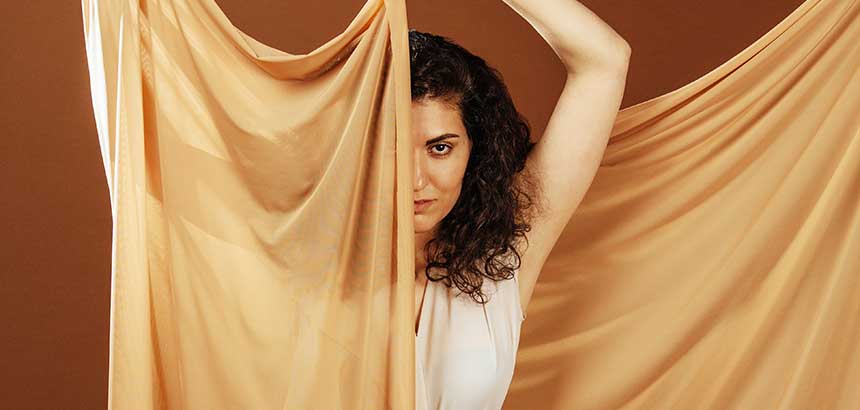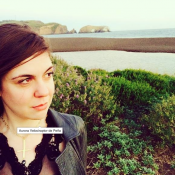I was walking down the street with – she’s not my mother, but she’s a mother figure. She’s about 65, and we ran into this other friend of mine. And this friend – he’s a lovely person. And he looked her in the eyes and shook her hand and said, ‘Hi, nice to meet you,’ and we talked, and when he left, she was so excited: ‘I can’t believe he looked me in the eye. I can’t believe he saw me.’”
Norah Sadava, one half of my iPad screen, takes a sip of her coffee. She
and Amy Nostbakken, the other half of my screen, are Quote Unquote Collective, and they’re taking a break from recording music for the film adaptation of their international hit play Mouthpiece to Skype with me about their new work, Now You See Her.
Sadava continues, “Because so often when you’re around young people, they don’t see you. You’re just this general wash, you’re the background.”
Nostbakken, nodding in agreement, tells me that the 65-ish character in their play, Joanne, is a journalist being given a lifetime achievement award, which comes with the unspoken message that she is to stop working and age gently out of sight. To become, after an accomplished life, part of the wash, part of the background.
Now You See Her is about all the insidious ways women fade away, get talked over, get written out, and disappear into the ether.
There are so many roads to vanish down while womaning, and Nostbakken and Sadava are walking them with a diverse team of collaborators to create their work. Initially conceived as a three-hander, Now You See Her’s scope has grown to include six actors. Characters include a scientist who is being written out of her own research; a new mother sucked into isolation, postpartum depression, and an eating disorder; a pop star pressured by the music industry to perform a version Blackness for white audiences at the expense of her real identity; and an exceptional Indigenous woman whose disappearance is, Nostbakken says, “quite obvious and literal.”
Quote Unquote’s three-year process has been extremely collaborative, and their team members have driven the collective development of the piece and their characters’ arcs. They’ve also invited outside eyes into the studio with the hope that no particular actor would have to feel the weight of speaking for their entire culture or community, or telling a disappearance story that felt like a dangerous trope. Each of the characters is painted by the experiences of the woman developing her, and her behaviours, her movements, her relationships are discussed in the room.
In a cast of vanished, invisible, and disappearing women, the conspicuously absent parties are men. I ask Nostbakken and Sadava whether they think men are responsible for the erasure of women. The question leads to an uncomfortable pause.
Nostbakken says no, men aren’t to blame, but the structure they created is. “I think it’s oversimplifying to say it’s just men – of course, it’s the patriarchy that’s hiding us and pushing us down again and again, over and over. But it’s being upheld by all of us. And yeah, women weren’t allowed to create the structure we have to live and function in. But we are functioning, and it’s built within us. Men disappear women, but a lot of women disappear each other, disappear themselves. You think about something like an eating disorder: who to blame for that is so complex it’s kind of not worth asking – well, it’s not worth blaming. It is worth asking. But in terms of women, we feed ourselves this toxic material of movies and media. We know it’s wrong, but we still do it. We feed it to our kids. So the play is less about who to blame and more about ‘Now what?’”
Now what? is the question the play asks, but it’s also a question the collective makers of Now You See Her are working to answer through the process of creation. The theme of disappearing women means something very different depending on the body you were born into. One woman’s workplace invisibility is another woman’s life.
Sadava and Nostbakken chose their collaborators with this in mind. They wanted the most gifted performers, people who could move, sing, and create the surreal physical, musical world that Quote Unquote is known for. But just as importantly, they wanted people who would call them out. Nostbakken says, “We chose people who were going to challenge us. We saw a lot of really talented actors, but we chose the ones we knew would not let us off the hook about anything and who would challenge the politics at every turn. We chose activists, people who want to be actively changing the world.”
Sadava elaborates: “A part of the core thesis of this piece is that we are a group of six women who come from very different backgrounds, who have different bodies, who are all of different ages. As women, we’ve been divided and pitted against each other so frequently that the impetus to listen and hold on to each other and move forward together has been torn away from us. What we are trying to do, even in building this play, is a political act in the room. That there’s six of us hearing each other out and trying to understand each other. It’s not about ‘We’re all the same.’ It’s about ‘I hear you. I hear your experience. And I empathize, and even if I don’t understand, I’m trying.’”
I ask, does it feel possible? Is it possible to move forward together? To make something together? Nostbakken takes a sip of coffee, and Sadava laughs. “It’s not a straight line. It’s not like ‘Oh yeah, forward is that direction, and we’re all doing it together.’”
So, instead, they tell me, they’ve been working together with their collaborators, engaging in questions.
“How do we not erase each other?”
“How do we listen?”
“How do we make each other feel more seen and heard?”
Now what?
photo by Tanja-Tiziana


